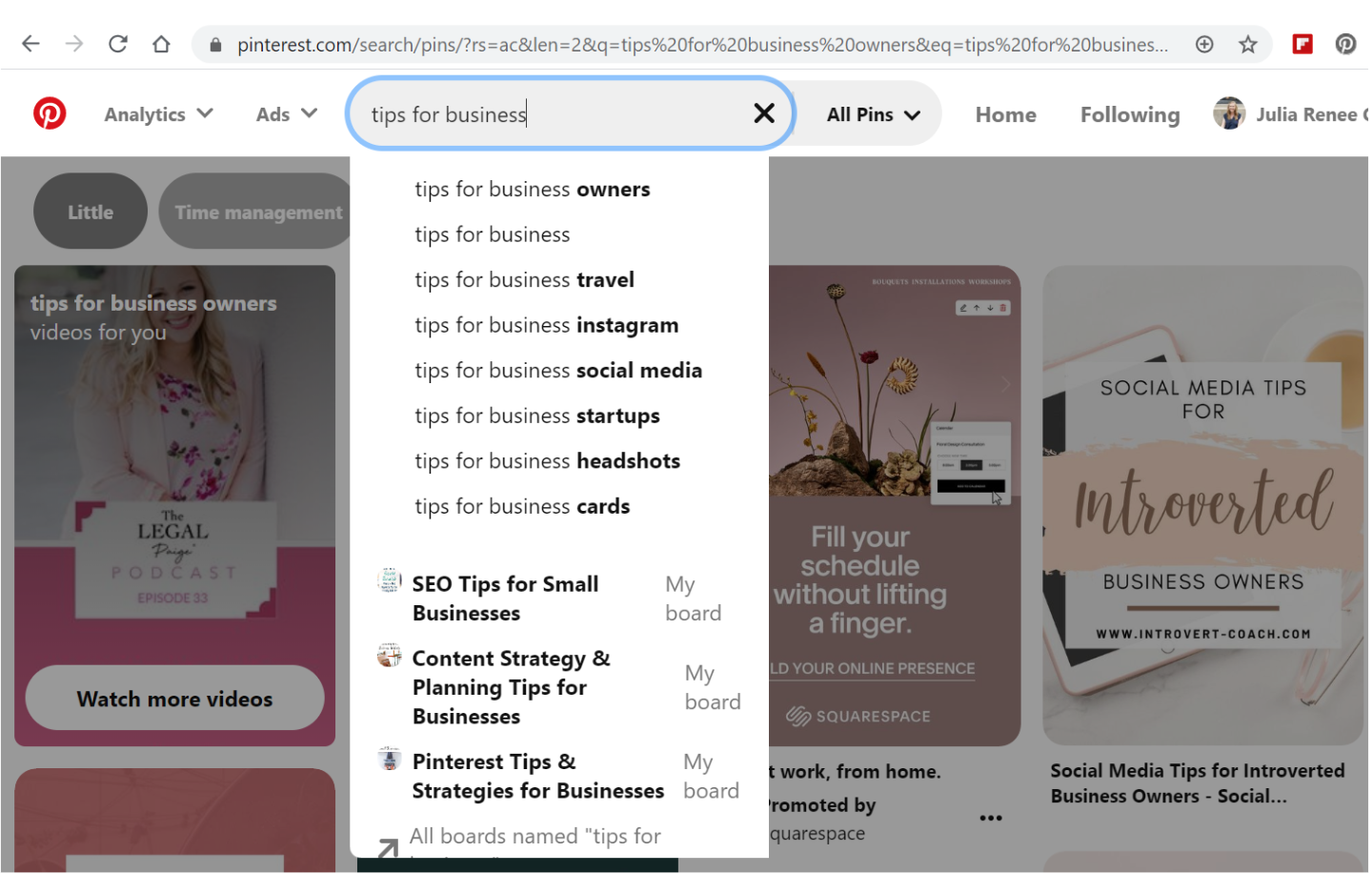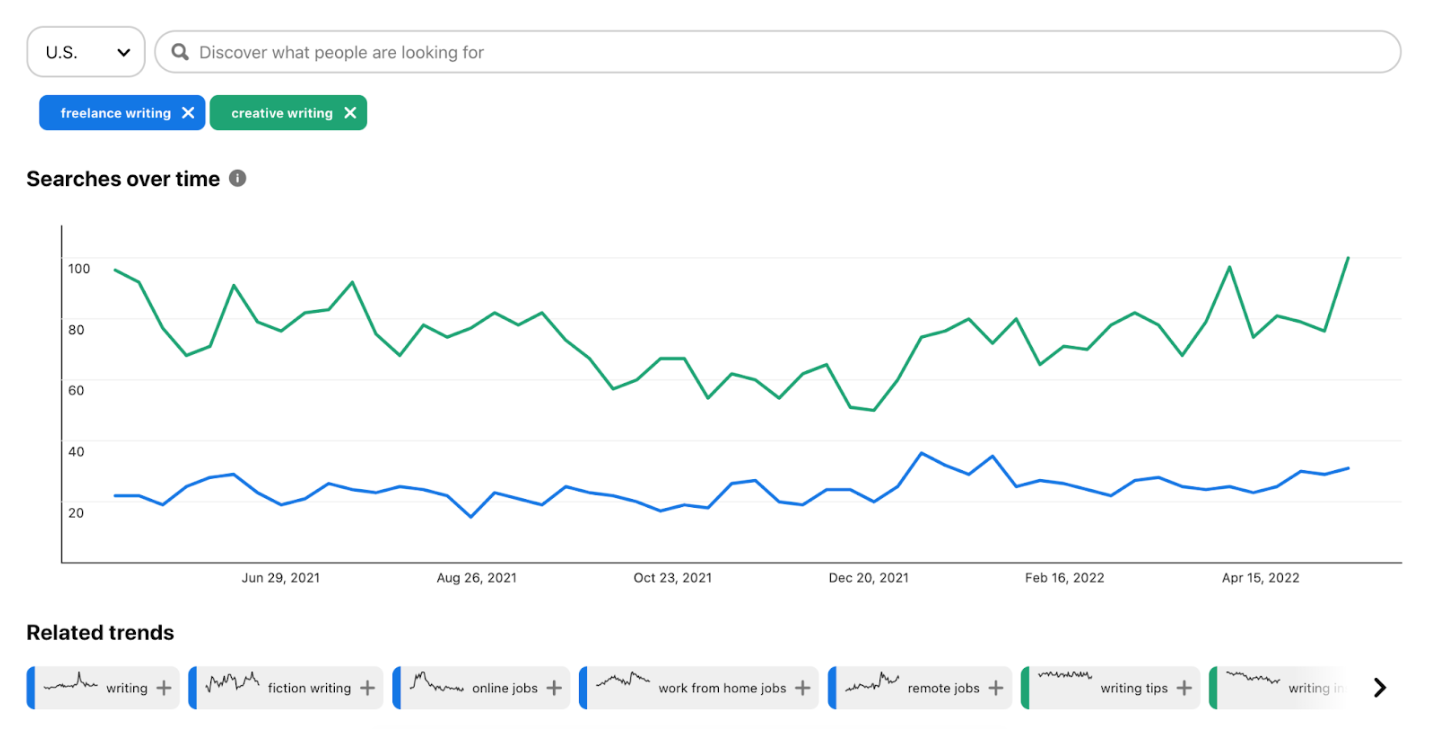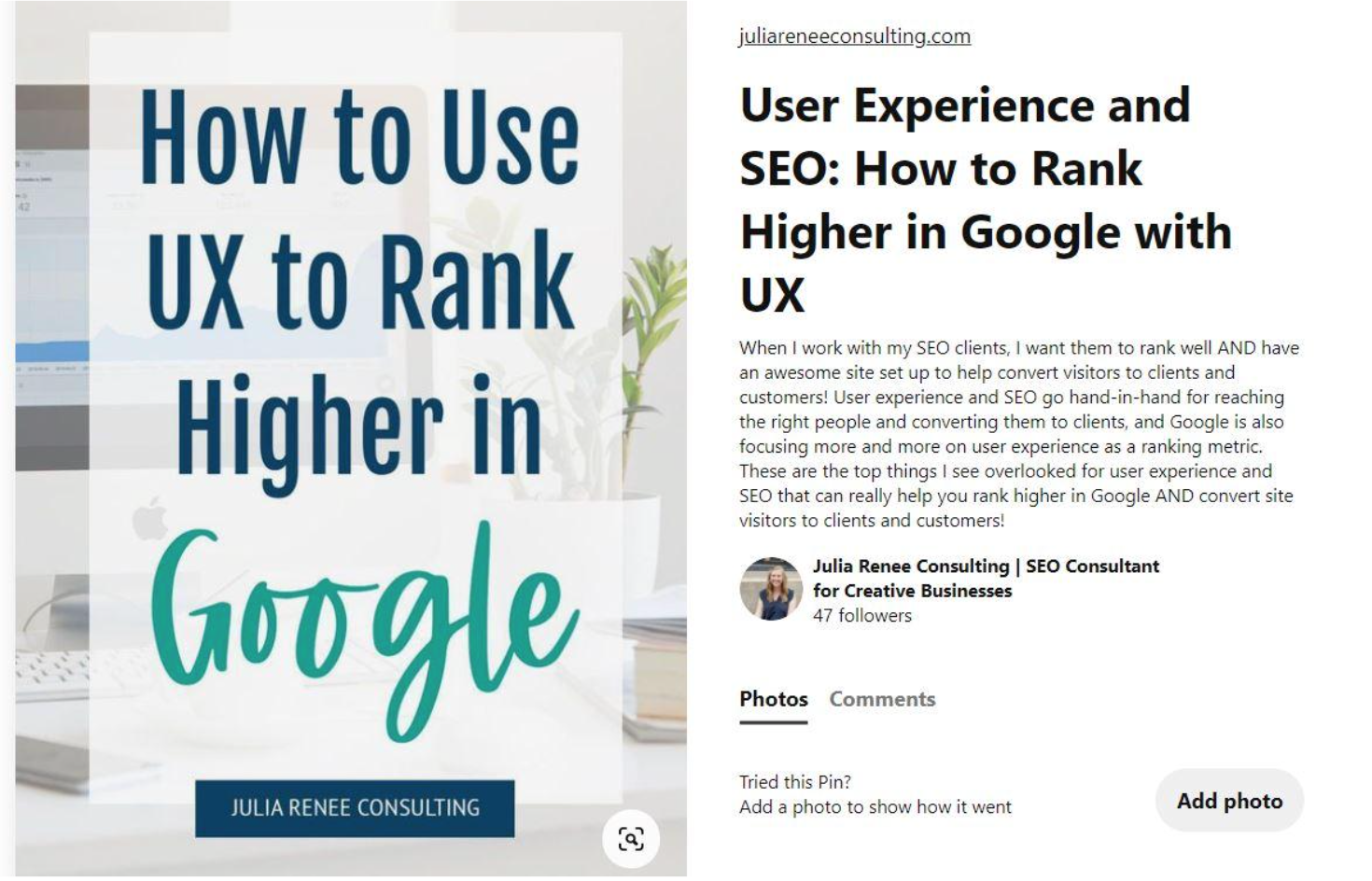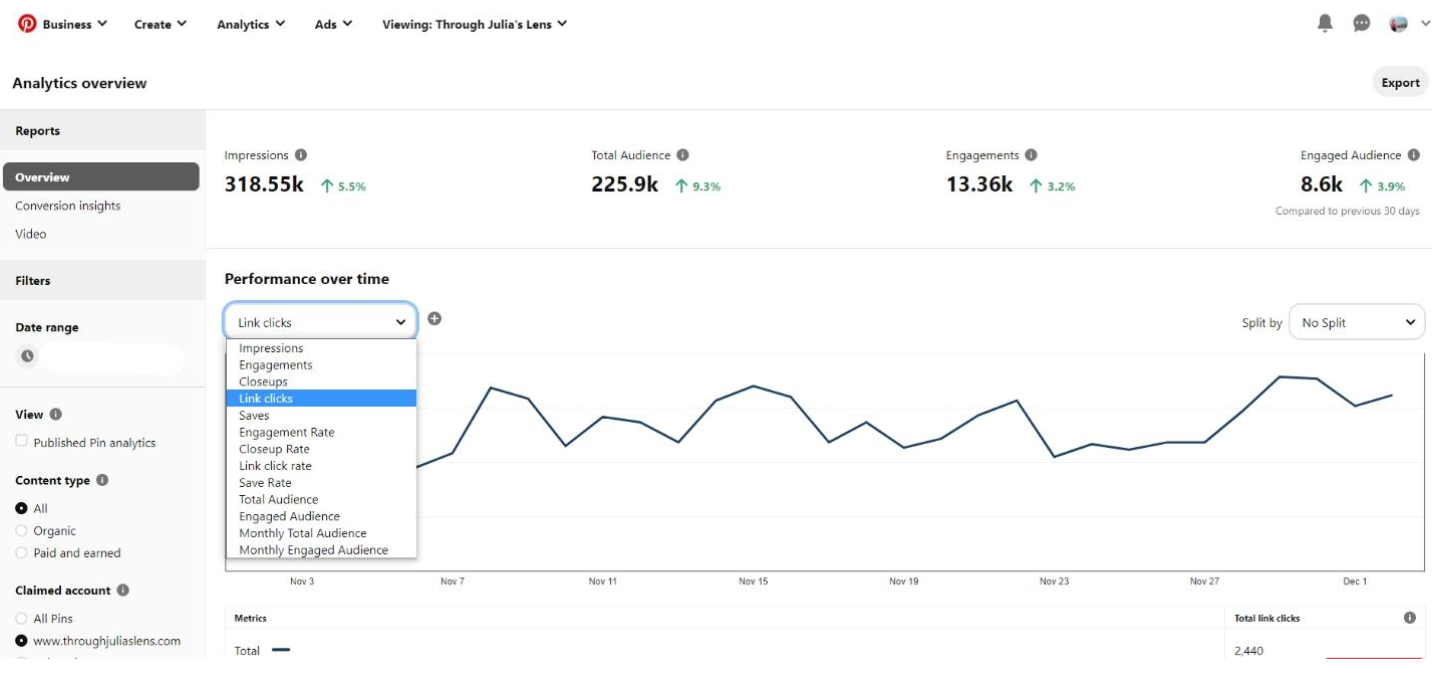Guest post by Julia Bocchese
Approach Pinterest like the search engine it is
Pinterest can be an amazing source of traffic for your content and products, but it’s pretty different from other social media platforms. And it’s actually not really a social media platform: Pinterest is a visual search engine.
While Pinterest does have some social media qualities, at its core, it’s used as a search engine with similar strategies to ranking on Google. So if you want to make sure you’re best using this amazing platform for your business, you need to focus on SEO strategies. Here are the foundational steps of Pinterest SEO to help you get started.
Understand how Pinterest works as a search engine
On Pinterest, you can have followers, comment on pins, and react to Idea Pins, similar to features and actions on social media platforms like Instagram and Twitter. But elements like followers or comments actually don’t matter to help you get lots of traffic from Pinterest (which is why this introvert loves Pinterest so much!).
When the majority of Pinterest users visit the platform, they’re looking for ideas or answers, and they go to the search bar to type in what they’re looking for. Pinterest isn’t a platform to check the news or see what your friends have been up to. So to get your content ranking on Pinterest and increase your traffic, you need to think of it more like ranking on Google.
Just like with Google, Pinterest uses keywords to understand what to rank content for. Keywords are just the words or phrases people type into Google or Pinterest when they’re searching for something.
And since there’s such an overlap between Pinterest and Google, your Pinterest content can actually rank well on Google, too! Since I focus on SEO and Pinterest in my business, I can’t tell you how many times I’ve been doing keyword research for my SEO clients and come across Pinterest profiles, boards, and pins ranking on the first page of Google for those keywords. So your Pinterest content has great potential for getting additional traffic if it ranks well on Google.
Figure out who to reach on Pinterest
The first step to getting traffic from Pinterest is figuring out who you can reach. Not every business will perform well on Pinterest, so do some research to see if your audience is using the platform.
For example, freelance writers writing for healthcare industries likely won’t perform very well on Pinterest because that market isn’t very active on Pinterest. But freelance writers who work with wedding industry professionals likely would perform well because there are a lot of people in the wedding industry who use Pinterest.
You can check Google Analytics under Acquisition to see if your audience is already pinning for you and driving traffic to your site. You can search keywords in Pinterest related to what your business does or the type of content you’re creating and see if anything pops up or if Pinterest autopopulates similar suggestions. For example, if you specialize in marketing for creative businesses, you can search some phrases like “Facebook tips for photographers” or “how to create Instagram graphics.”
If businesses like yours are on Pinterest, and you can see that they have a good number of monthly viewers, it’s probably a good indication that your business could do well on Pinterest, too.
If you’re unsure if your business will perform well on Pinterest, it doesn’t hurt to test it out! Give it at least three to four months of pinning consistently to see if your traffic starts to grow to decide if it’s worth staying on Pinterest. You can expect your traffic to grow about 1-5% each month.
How to do keyword research for Pinterest
Once you’re ready to give Pinterest a try, you need to start with keyword research. Keywords are the foundation of getting your content to rank on Pinterest, and you want to make sure you’re targeting keywords that aren’t too broad or too specific that no one is searching for them.
There isn’t a perfect science with keyword research, and Pinterest doesn’t have the same great tools as you can use for ranking on Google (yet). So you may have to test things out and see how your content performs. You can use SEO keyword research tools to get an idea of what types of phrases people are searching, but just be aware that the data won’t be the same for Pinterest as it is for Google.
If you want to test out SEO tools, I recommend free tools like Ubersuggest to get started. If you really want to dig into the data for your site and Pinterest, Keysearch is a good keyword research tool that’s reasonably priced, and more expensive tools like Moz, Semrush, and Ahrefs will have keyword research information and lots of other data for your site and competitors.
For Pinterest keyword research specifically, you can start typing phrases into the search bar on Pinterest and see what autopopulates to see what keywords other people have searched for. The longer the phrase, the easier it usually is to rank for. Pinterest also has a tool called Pinterest Trends to see what keywords people are searching and the search trends throughout the year, but it’s a pretty new tool so they don’t have a ton of data yet. Don’t be discouraged if keywords related to your industry don’t have any data on Pinterest Trends yet.
To use Pinterest Trends, type in a phrase that you want to get information for. If they don’t have information for the exact keyword, try getting a little creative with the phrasing and see if you get more data.
When you do find a keyword with information, they’ll show you a graph with the seasonal trends, which will help you plan ahead on your content. You’ll also see “Related terms” under the graph for more content ideas.
Optimize your profile and boards
Once you have some keywords to start with, there are a few places you can use them. The first place is on your Pinterest profile itself. You can use keywords about your business in your account name and business description. And don’t keyword stuff or fill the description with a string of keywords — write a description that will get someone interested in following you or visiting your website while incorporating a keyword or two to help Pinterest understand your profile.
It's also important to use keywords in your board titles and descriptions to help Pinterest understand your content further and because there’s a potential to rank on Google. Boards are simply the different categories your content will be pinned to, and I recommend getting fairly specific with the topics.
Instead of names like “Business” or “Photos,” use titles like “Business Growth Tips for Photographers” or “LinkedIn Tips for Freelance Writers.” And you can add a short description to give Pinterest (and Google) even more information to understand what that board’s content is about.
Use keywords on pin designs and descriptions
The most important place to use keywords is on the pins themselves. Use your keywords in the pin title, pin description, and on the actual pin design. And again, don’t just have a string of keywords in the title and description because it can look spammy to someone who reads it (and likely won’t help them click over to your website). Just write a clear title and brief description that describe your content and get someone interested in clicking to your website for more information.
Pinterest’s AI tool is getting smarter and can actually read most text on pin graphics, so you want to make sure you’re using keywords in the text on your pins. Plus, when someone is scanning pins and sees the keyword they searched on your pin graphic, it can catch their eye better and get them to click on it. You can also test out different titles on the graphic to see what might get more attention and drive more traffic.
When you’re doing keyword research, you’re probably going to find a few different keywords that you could use for a pin. I always recommend testing out different designs for pins, and you should test out different keywords, too. There might be one that you find resonates more with your ideal audience than another, but you won’t know for sure until you test them.
To test how different keywords are performing, I recommend taking the same (or a similar) pin design and just changing up the title and description and pinning it to a different, relevant board. Then you can track the two pins and see which one performs better. Group boards aren’t very beneficial to increasing your traffic anymore, so I recommend just pinning to your own boards.
Track your progress in Pinterest Analytics
To track how different keywords or designs are performing and to see if your traffic from Pinterest is growing, Pinterest has its own analytics built in. You do need to make sure you have a business account and that you claim your website on Pinterest to get analytics specifically for your website(s). If you currently have a personal Pinterest account, you can easily switch it to a business account to start accessing your analytics.
In Pinterest Analytics, there are a lot of different metrics you can check, and I recommend focusing on Saves (the saves your pins are getting from other accounts) and Outbound Clicks (the traffic from Pinterest to your website).
I don’t recommend focusing on Impressions because it can just be an inflated vanity metric, and it doesn’t show actual engagement with your pins. Impressions simply means that someone has seen your pin, but they could have scrolled right past it without taking any action. You want to make sure your pins are being reshared and driving traffic to your site, so that’s why I recommend focusing on engagement.
Below the graph of metrics, you can also see the exact pins getting the most Saves, Outbound Clicks, Impressions, etc. This is where you can see which topics, designs, and keywords are performing the best to help you with your strategy.
Pinterest usually has slow but steady growth and compounds over time, so don’t be discouraged if you’re not getting much traffic in the first month or two. You need to build up your content and trust with Pinterest, and it can take time to start ranking well, just like on Google. So give it a few months of pinning consistently and testing out different designs and keywords to see if your content has good potential on Pinterest.
You can repin older content to give it another boost, and I recommend repinning a pin about once a month so you’re not reposting the same pin too closely together.
So now that you know how to use and understand Pinterest SEO, it’s time to get started! Test different keywords and strategies to see what works best for your account, and if you have any questions about Pinterest, feel free to reach out to me at julia@juliareneeconsulting.com.
About Julia Bocchese
Julia Bocchese is an SEO and Pinterest Consultant for creative small businesses at Julia Renee Consulting and recently became the first SEO professor at Drexel University. Her goal is to make SEO and Pinterest strategies approachable and easy to implement for all small businesses so they can reach their ideal clients organically. She lives in Philadelphia with her Siberian Husky sidekick and her husband, and on the side, she runs a travel photography site and experiments with spicy recipes in the kitchen.
You might also be interested in:






